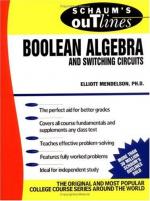|
This section contains 371 words (approx. 2 pages at 300 words per page) |
A system of expressing problems in logic algebraically worked out by a self-taught English mathematician in the mid-1800s formed the basis for modern computer programming. The discoverer of this system was George Boole (1815-1864), born in Lincoln, England, in 1815. Boole's father was a cobbler with a great interest in mathematics, which he passed on to the boy. At age sixteen, though he had little formal education, Boole began teaching, and at age twenty he opened his own school. He devoted his spare time to studying mathematics and began contributing papers on the subject to the newly established Cambridge Mathematical Journal in 1840. In 1849, though he had never earned a university degree, Boole was appointed professor of mathematics at Queen's College, Cork, Ireland. He held this post until his death in 1864, a result of his devotion to teaching: he insisted on lecturing in wet clothes after a two-mile walk through a cold November rain and then succumbed to pneumonia.
Boole began his investigations into the connection between mathematics—specifically, algebra--and logic in the 1840s. He published his findings in an 1847 pamphlet, The Mathematical Analysis of Logic, and his great work of 1854, An Investigation of the Laws of Thought, on Which Are Founded the Mathematical Theories of Logic and Probabilities. In these books, which established what is now called symbolic logic, Boole explained what Gottfried Leibniz had tried to work out much earlier: how to convert logic into mathematic symbols. He set out logical axioms for logic and chose symbols and operations similar to algebraic notation to express the logical forms and perform the operations. The basic operations in Boolean algebra are AND, OR, and NOT; objects either do or do not share particular properties. Boole had worked out a way to reduce human reasoning to a series of yes-or-no choices.
Boolean algebra attracted little attention until the twentieth century. In his 1938 master's thesis for MIT, Claude Shannon (b. 1916) showed how to apply the binary nature of Boolean algebra, or symbolic logic, to relay circuits, which are either open or closed. Computer scientists were soon able to use Boolean algebra to work out programs of logical commands communicated to the computer through binary (on or off) circuit operations.
|
This section contains 371 words (approx. 2 pages at 300 words per page) |


